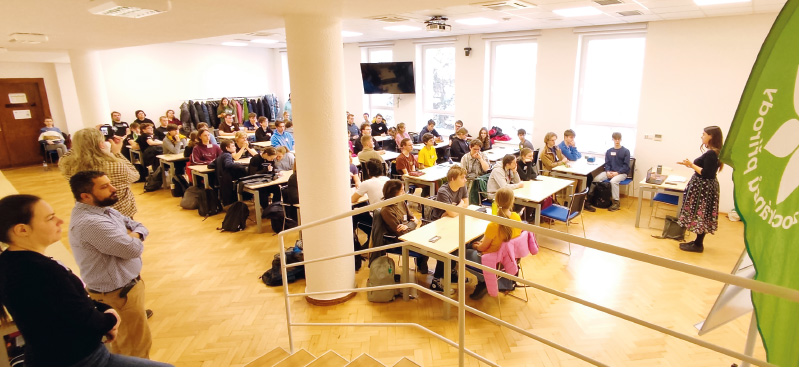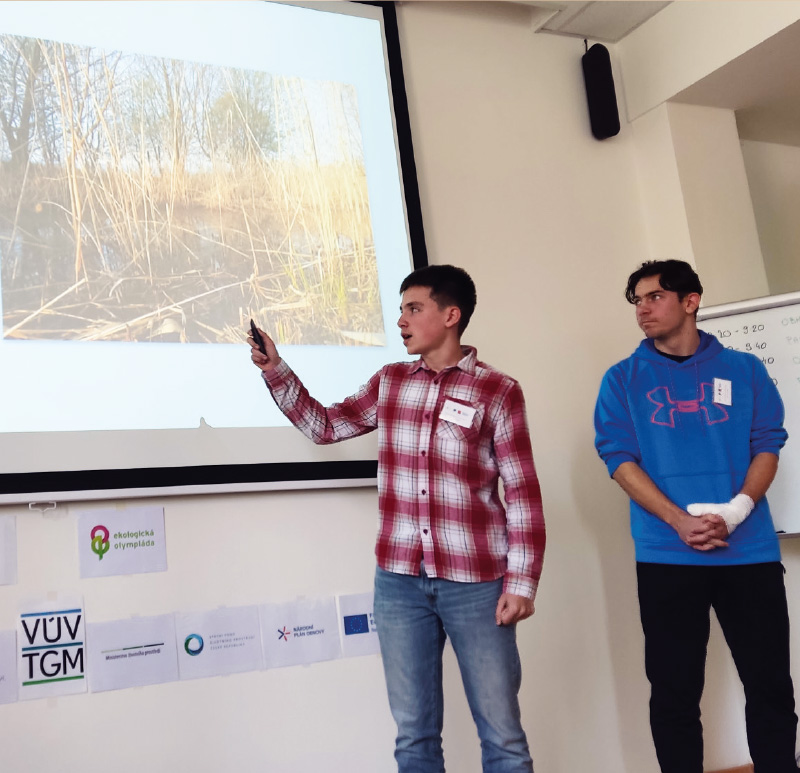
Fig. 1. The regional round director Valérie Štylerová launches the 30th year of the Ecological Olympics in the TGM WRI cinema in Prague
It has been 30 years since the first round of the Ecological Olympics competition took place. Over the past three decades, it has gradually spread from Wallachia to the entire country and has become a recognized competition, praised by many universities.
In the 1990s, when the competition was created, ecology and the related environmental protection were already discussed not only in professional circles, but also in the media, and this topic gradually became known to the general public. At that time, Mr. Vlastislav Huška, a professor at Nový Jičín grammar school, decided to organize the first round of a science competition, which he called the Ecological Olympics. Ecology was not yet a commonly taught subject then, so this competition became part of the promotion of education in the field of environmental protection.
Miroslav Janík, a member of the basic organization of the Czech Union for Nature Conservation (ČSOP Kosenka), who sat in the jury at the time, also participated in the organization of the first year. The competition enthused him so much that the following year, ČSOP Kosenka organized it in Valašské Klobouky. In the following years, there were several rounds until the Ecological Olympics gradually became a nationwide competition.
Since its first year, the Olympics has been unique in its team spirit. There are not many other knowledge competitions in which three-member teams compete. Another advantage is its direct connection with practice; in each round, students solve a real issue related to environmental protection in a given area, whether it is management of an orchid meadow (the first field task in Valašské Klobouky), or assessing the plan to expand a car park at Jizerka in the most exposed part of the Jizerské Mountains (task in the 21st national round). Students defend their proposed solutions in front of an expert jury, which also tests the competitors’ skills in presenting their work.
Fig. 2. The juror Ing. Jan Moravec with students
Fig. 3. Students in three-member teams solve the botanical part the “identification” task
Fig. 4. It included identifying the sounds of our birds and frogs
Fig. 5. On the second day of the competition, the students defended their field practical task…
Fig. 6. … which was designing the restoration of the Únětický stream
Fig. 7. The three best teams of the Prague regional round; the winning team (in the middle) advance to the national round
Since its inception, the Ecological Olympics has also developed in the topics that it focuses on each year. In its early days, each regional and national round focused on its own topic, which was up-to-date in the location of the respective round of the Olympics. At present, every year, a single nationwide theme is announced, and each regional and national organizer adapts to it with their field practical task. This year’s theme is Water in the Landscape and Adaptation to Climate Change. Thanks to this unification, students have the opportunity to better prepare for the competition. Since it is rarely a topic that they would find comprehensively presented in regular secondary school textbooks, we organize a summer camp for them every year, and publish a methodology focused on the current year’s topic. A similar methodology is also created for organizers to help them navigate issues that may not be so familiar to them.
In addition to the practical field task, the competing teams also compare their knowledge in theoretical areas within a given topic, such as identifying natural objects or in a test. In some regional rounds, teams also have “homework” to bring to the competition, or they participate in a so-called mini-graduation exam, during which they discuss a topic with an expert jury. Most regional rounds last two to three days, so there is plenty of time for an accompanying programme, such as excursions, lectures, discussions, but also dance evenings or theatre performance prepared by the participants themselves. The of the regional round winners meet in the national round, which takes place for three to four days in June of the given school year, each time in a different region. Its programme is similar to that of the regional rounds.
This year’s regional Prague round took place on 20–21st March 2025 and was hosted by TGM WRI in Prague. A total of 52 students participated. The winning team was from Gymnázium Jana Keplera consisting of students Naxerová, Hromas, Koucký, which received 128.5 points out of a possible 160. Second place was taken by the team of Arachne, z. s., with 116 points, and the “bronze” medal was taken by the second team of Arachne, z. s. with 111 points.
Over the years, the Ecological Olympics’ popularity has grown, reaching a steady level of approximately 400 students taking part in it each school year. Information about the competition is also published annually in the Informative List of Competitions (formerly the Bulletin) published by the Ministry of Education, Youth and Sports. The high level of the competition expertise has also attracted the attention of many universities, which take Olympics participation into account for those interested in studying in the admissions procedure for related fields.
We are currently working towards organizing the Ecological Olympics at a school round level. Over the past few years, there have also been discussions about the possibility of expanding the competition to neighbouring countries and organizing an international competition.
This year, we will have four regional rounds and one national round, which will be organized in the Central Bohemian Region by ČSOP Vlašim.
The organizer of the Ecological Olympics is the Czech Union for Nature Conservation (ČSOP), the implementer is the SMOP ČSOP, and the co-announcer is the Ministry of Education, Youth and Sports.
Details can be found on the national website of the competition
www.ekolympiada.cz, information directly related to the Prague regional round at:
http://praha.ekolympiada.cz/
An informative article that is not subject to peer review.
Authors of the photos:
Bc. Kateřina Landová, Alžběta Doležalová, Ing. Jan Moravec






